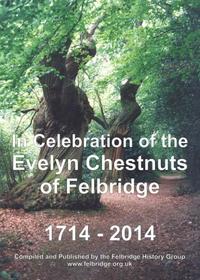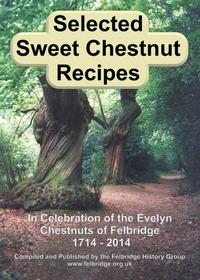History
The Evelyn Chestnuts were planted in 1714 to mark the restoration of the Protestant Monarchy when George I was crowned. They were planted by William Evelyn hence why they have been called the Evelyn Chestnuts.
There were originally 104 trees planted in two avenues of 52 trees each. One avenue is on the north side of what is now Crawley Down Road, the other avenue is lies a little south of what is now the line of Copthorne Road. This second avenue runs through the school grounds, behind the Village Hall and ends alongside the Twitten in Rowplatt Lane.
Trees have been lost during the last 300 years and only about 40 of the original ones remain today. There have also been replacement trees planted but not all of them are Sweet Chestnuts, there are several Horse Chestnut (Conkers) planted in 1964 and an Oak that was planted at least 100 years ago.
Please acknowledge our group if using any of this material.
|
|
|
|
The Evelyn Chestnuts are all twisted but the reason for it twisting is not understood and Sweet Chestnuts do not always twist. The tree is more likely to start twisting after it is 150 years old. The footpath between Rowplatt Lane and Felbridge School is on the line of the original track along this avenue. The track led to Felbridge Park. On the left of the footpath is a bank, which was the boundary of the fields enclosed out of what was known as Felbridge Heath. The fields were enclosed either just before or at the same time as the trees were planted. There would have been beech trees planted on the bank to form the other side of the avenue, we can tell this as there are a few descendants of those trees still present today. |
Laying the Water main in 1926 |
|
The clump behind the bench at the front of the school is actually the remains of one of the Evelyn chestnuts, venture round to the right to see the stump and the chestnut trees that have grown up from the shoots (epicormic growth) that grow at the base of the older chestnut trees. These saplings are now visible as chestnut boughs above the clump. The line of Evelyn Chestnuts had turned by this point and continued through the school grounds the next tree was close the where the boiler house is now and beyond that was one in the garden of the old school house. |
Picture taken looking back down Crawley Down Road, the building on the left is the Village Shop |
|
The last surviving Evelyn Chestnut in the southern avenue of trees lies to the north east of the old school house. The avenue originally led to the entrance to Felbridge Park which was later called Felbridge Place when the Gatty family purchased it in 1856. The entrance to Felbridge Park is now marked by the large wooden gate (just to the right of the telephone box) and the footpath beyond it. |
Note the chestnut trees immediately left of the school and the one in front of the School House both of which were removed before 1908. |
|
The northern avenue of trees runs through the school grounds, glimpses of these trees can be seen as you walk along Copthorne Road. |
 |
|
|
 |
|
The avenue of trees behind the Village Hall gives a very good impression of what both avenues would all have looked like. Photograph donated by M. Heselden |
 |
|
|
 |
|
This image from the 1950's was taken just west of where the entrance to McIver Close is today. The two trees in the foreground have been replaced with coner trees, but the third Evelyn Chestnut in the picture (leaning to the left) is still standing. |
 |
|
This view was taken from the bus stop in Crawley Down Road looking back towards Felbridge School, it dates from the 1930's.
|
 |
| This picture is taken from west of the Crawley Down Road bus stop looking back towards Felbridge School. Note Vine Cottage on the right hand side of the picture which is still visible today. All of the Evelyn chestnut trees in this area have been removed.
|
 |
|
This picture of the end of Rowplatt Lane shows the Evelyn Chestnut that stood next to the surviving oak tree. Please contact us if you have images of people or places in Felbridge. |
 |

 The first book is about Sweet Chestnut trees in general and then the history of our avenues of trees.
The first book is about Sweet Chestnut trees in general and then the history of our avenues of trees.

